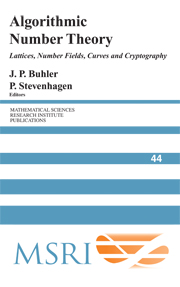Book contents
- Frontmatter
- Contents
- Preface
- Solving the Pell equation
- Basic algorithms in number theory
- Smooth numbers and the quadratic sieve
- The number field sieve
- Four primality testing algorithms
- Lattices
- Elliptic curves
- The arithmetic of number rings
- Smooth numbers: computational number theory and beyond
- Fast multiplication and its applications
- Elementary thoughts on discrete logarithms
- The impact of the number field sieve on the discrete logarithm problem in finite fields
- Reducing lattice bases to find small-height values of univariate polynomials
- Computing Arakelov class groups
- Computational class field theory
- Protecting communications against forgery
- Algorithmic theory of zeta functions over finite fields
- Counting points onvarieties over finite fields of small characteristic
- Congruent number problems and their variants
- An introduction to computing modular forms using modular symbols
Lattices
Published online by Cambridge University Press: 30 May 2025
- Frontmatter
- Contents
- Preface
- Solving the Pell equation
- Basic algorithms in number theory
- Smooth numbers and the quadratic sieve
- The number field sieve
- Four primality testing algorithms
- Lattices
- Elliptic curves
- The arithmetic of number rings
- Smooth numbers: computational number theory and beyond
- Fast multiplication and its applications
- Elementary thoughts on discrete logarithms
- The impact of the number field sieve on the discrete logarithm problem in finite fields
- Reducing lattice bases to find small-height values of univariate polynomials
- Computing Arakelov class groups
- Computational class field theory
- Protecting communications against forgery
- Algorithmic theory of zeta functions over finite fields
- Counting points onvarieties over finite fields of small characteristic
- Congruent number problems and their variants
- An introduction to computing modular forms using modular symbols
Summary
It occurs frequently in algorithmic number theory that a problem has both a discrete and a continuous component. A typical example is the search for a system of integers that satisfies certain inequalities. A problem of this nature can often be successfully approached by means of the algorithmic theory of lattices, a lattice being a discrete subgroup of a Euclidean vector space. This article provides an introduction to this theory, including a generous sample of applications.
A latticeis a discrete subgroup of a Euclidean vector space, and geometry of numbersis the theory that occupies itself with lattices. Since the publication of Hermann Minkowski’s Geometrie der Zahlen in 1896, lattices have become a standard tool in number theory, especially in the areas of diophantine approximation, algebraic number theory, and the arithmetic theory of quadratic forms.
The theory of continued fractions, principally developed by Leonhard Euler (1707–1783), is in substance concerned with algorithmic aspects of lattices of rank 2. A significant advance in the algorithmic theory of lattices of general rank occurred in the early 1980’s, with the development of the powerful lattice basis reduction algorithm that came to be called the LLL algorithm [Lenstra et al. 1982]. The LLL algorithm has found numerous applications in both pure and applied mathematics.
In algorithmic number theory, geometry of numbers now plays a role that is comparable to the role that linear programming plays in optimization theory, and that linear algebra plays throughout mathematics. This is due to a similar combination of circumstances: good algorithms are available for solving the basic problems, and many commonly encountered problems reduce to those basic problems. Just as a multitude of problems in mathematics can be linearized, so can many others be addressed by the introduction of a suitable lattice. Typically, this applies to problems that have both a discrete and a continuous component, such as the search for a system of integers that satisfies certain inequalities. Algorithmic number theory abounds in such problems.
Information
- Type
- Chapter
- Information
- Algorithmic Number TheoryLattices, Number Fields, Curves and Cryptography, pp. 127 - 182Publisher: Cambridge University PressPrint publication year: 2008
Accessibility standard: Unknown
Why this information is here
This section outlines the accessibility features of this content - including support for screen readers, full keyboard navigation and high-contrast display options. This may not be relevant for you.Accessibility Information
- 3
- Cited by
